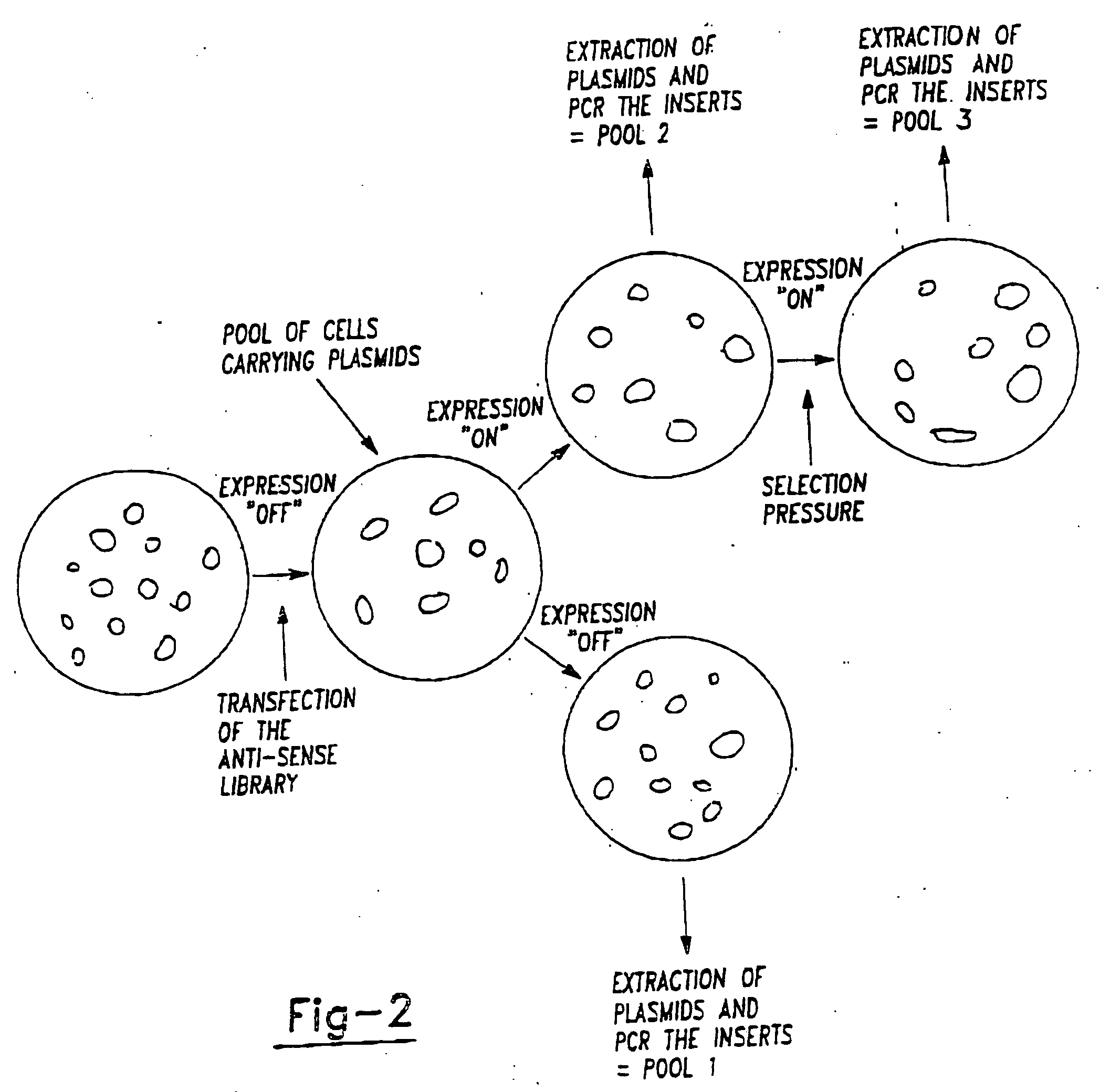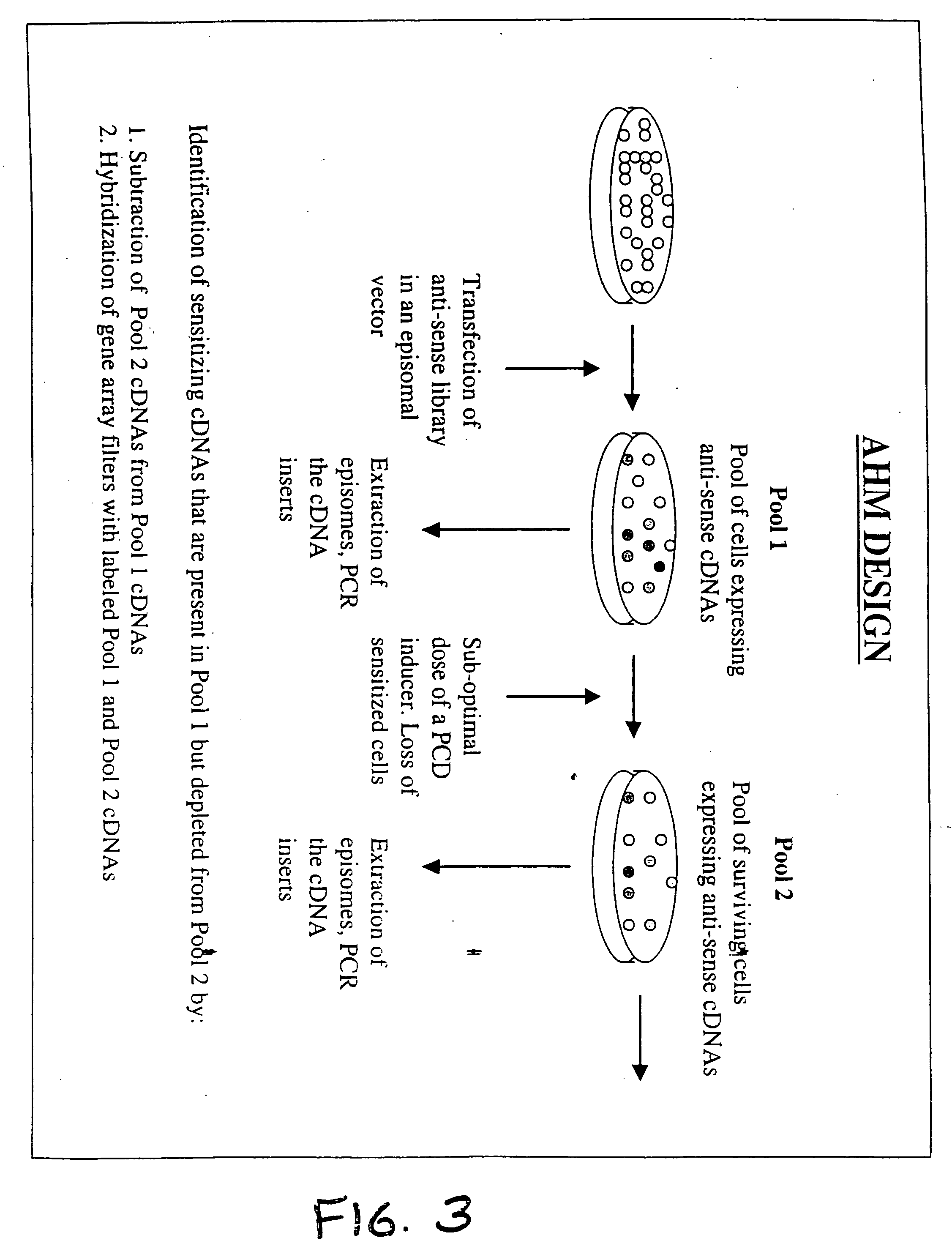Therapeutic modulation of the fas pathway
a therapeutic modulation and pathway technology, applied in the field of identifying genes, can solve the problems of inefficient and rapid methods, method has the limitation of requiring a phenotype that can be efficiently selected, and method has significant disadvantages for large-scale gene identification
- Summary
- Abstract
- Description
- Claims
- Application Information
AI Technical Summary
Benefits of technology
Problems solved by technology
Method used
Image
Examples
examples
General Methods
[0112] General methods in molecular biology: Standard molecular biology techniques known in the art and not specifically described were generally followed as in Sambrook et al., Molecular Cloning: A Laboratory Manual, Cold Springs Harbor Laboratory, New York (1989, 1992), and in Ausubel et al., Current Protocols in Molecular Biology, John Wiley and Sons, Baltimore, Md. (1989).
[0113] Polymerase chain reaction (PCR) was carried out generally as in PCR Protocols: A Guide To Methods And Applications, Academic Press, San Diego, Calif. (1990).
[0114] Reactions and manipulations involving other nucleic acid techniques, unless stated otherwise, were performed as generally described in Sambrook et al., 1989, Molecular Cloning: A Laboratory Manual, Cold Spring Harbor Laboratory Press, and methodology as set forth in U.S. Pat. Nos. 4,666,828; 4,683,202; 4,801,531; 5,192,659 and 5,272,057 and incorporated herein by reference.
[0115] Recombinant Protein Purification is undertake...
specific examples
Example 1
Determination of Combination of Methods for Preferred Embodiment
[0146] The method requires two distinct major steps as described herein above. It is greatly advantageous if this method can be applied to a wide variety of cells and situations. In the first step genes are inactivated in order to determine whether individual genes are essential for a specific phenotypic change. It is advantageous if these inactivation will have a phenotype both in haploid cells and in diploid cells. Since many cells of interest are diploid in nature. Furthermore, it is also an advantage if the inactivation method allows for the rapid identification of the inactivated genes. This can be achieved in a variety of manners. The inactivation methods are generally based on one of three different principles.
[0147] The first principle is that genes can be functionally inactivated by expressing mRNA that is derived from the anti-sense strand of the sense message.
[0148] This allows for inactivating t...
example 2
Identification of Genes in HeLa Cells that are Involved in fas Antibody Sensitivity
[0169] The method of the present invention was applied to HeLa cells treated with anti-Fas antibody in order to identify genes that when knocked-out cause sensitization of HeLa cells to the action of anti-Fas antibodies.
[0170] HeLa cells are derived from a human cervical carcinoma and were used in the original TKO [Deiss and Kimchi, 1991]. HeLa cells were used as an exemplar of the method of the present system as they are easily grown in culture, are easily transfected and respond to anti-Fas antibody treatment.
[0171] Anti-Fas antibody (Kamiya Biomedical Company, Seattle, Wash., catalog number: MC-060) is directed against Fas / CD95 / Apo-1, a transmembrane receptor that is known to signal a death response in a variety of cell types. This antibody is an activating antibody, that is, the binding of the antibody mimics the effects of binding of ligand. Applying the appropriate dose to responding cells ha...
PUM
| Property | Measurement | Unit |
|---|---|---|
| density | aaaaa | aaaaa |
| pH | aaaaa | aaaaa |
| pH | aaaaa | aaaaa |
Abstract
Description
Claims
Application Information
 Login to View More
Login to View More - R&D
- Intellectual Property
- Life Sciences
- Materials
- Tech Scout
- Unparalleled Data Quality
- Higher Quality Content
- 60% Fewer Hallucinations
Browse by: Latest US Patents, China's latest patents, Technical Efficacy Thesaurus, Application Domain, Technology Topic, Popular Technical Reports.
© 2025 PatSnap. All rights reserved.Legal|Privacy policy|Modern Slavery Act Transparency Statement|Sitemap|About US| Contact US: help@patsnap.com



